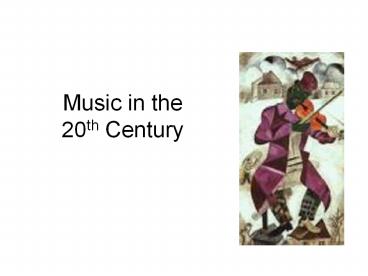Music in the 20th Century - PowerPoint PPT Presentation
Title:
Music in the 20th Century
Description:
Music in the 20th Century 20th Century Culture and the Arts Cultural Background Impact on the Arts Cultural Background Technology and Scientific Advancements ... – PowerPoint PPT presentation
Number of Views:418
Avg rating:3.0/5.0
Title: Music in the 20th Century
1
Music in the 20th Century
2
20th Century Culture and the Arts
- Cultural Background
- Impact on the Arts
3
Cultural Background
- Technology and Scientific Advancements
- Economics
- World Conflict
- Psychological Research
- Age of Diversity, Age of Eclecticism
4
Impact on the Arts
- The arts reflected cultures diversity,
eclecticism. - Artists tended to be of three sorts those that
sought to overthrow the status quo, to shock
those that experimented and seldom perfected
those that combined the two, who honored the past
but felt free to move beyond it.
5
Visual Arts
- Impressionism
- Claude Monet
- (1840-1926)
- French
6
(No Transcript)
7
- Cubism, Surrealism
- Pablo Picasso
- (1881-1973)
- Spanish
8
(No Transcript)
9
- Abstract
- Wassily Kandinsky
- (1866-1944)
- Russian
10
(No Transcript)
11
- Modernism
- Henri Matisse
- (1869-1954)
- French
12
(No Transcript)
13
Classical Music in the 20th Century
- Music from 1900 to 1950
- Musical Elements
- Variety of Styles
- Music After 1950
14
Music Elements
- Melody
- Music relied less on melody
- Irregular, unbalanced melodies
- Angular, instrumental in conception
- Rhythm
- Hallmark one of the most striking elements
- Increasingly complex, irregular meters and
accents, use of polyrhythms
15
- Harmony
- No single accepted harmonic language
- New chords polychord, quartal, tone cluster
- Atonality freedom from a tonal center, greatly
dissonant - Texture
- Homophonic
- Renewed interest in polyphony (counterpoint)
16
- Timbre/Orchestration
- Became more important than ever
- Trend toward smaller orchestra with a leaner
sound (economics) - Emphasis on percussion
- Less emphasis on a blended sound
- Dynamics
- Gradual, less extreme
- Form
- Divergent
- Genres
- Vocal Mass, Requiem, art song, opera
- Instrumental Symphony, Concerto, String Quartet
17
Musical Styles
- Impressionism
- Nationalism
- Neoclassicism
- Expressionism
- Serialism
- Avant-garde
18
Impressionism
- Transition style from late 19th century to early
modernism - Sought to suggest, rather than to define
- Impacted by impressionist art and literature
19
- Claude Debussy
- (1862-1918)
- French
- Prelude to the Afternoon of a Faun
20
Nationalism
- Encouraged use of authentic national songs,
dances, stories
21
- Aaron Copland
- (1900-1990)
- American
- Appalachian Spring
22
Neoclassism
- Revived the techniques, forms and musical styles
characteristic to Renaissance, Baroque and
Classical music - Introduced 20th century elements of sound within
these older styles
23
- Igor Stravinsky
- (1882-1971)
- Russian
- Rite of Spring
24
Expressionism and Serialism
- Sought to express inner emotions (as opposed to
Impressionism) - Abandoned tonality, used 12-tone scale
- Total Serialism
25
- Arnold Schoenberg
- (1874-1951)
- Austrian/American
- Vorgefühle from Five Pieces for Orchestra
26
Avant Garde
- Sought to overcome years of neglect in the
musical elements timbre and rhythm - Public often disassociated from this style
- Styles Aleatory (chance), electronic,
multimedia, digital
27
- Edgard Varese
- (1883-1965)
- French
- Poeme Electronique
28
Classical Music Traditions Since 1950
- Important Influences womens movement,
economics of composing, computer and digital
improvements - Eclectic, diverse styles electronic, computer
generated, serialism, romantic revival
(melodically centered)
29
Folk and Popular Styles
- Jazz
- Music Theatre
- Rock
30
Jazz
- Americas Musical Art
- Major contribution of the Black culture to the
contemporary culture - It was a players art.
- Styles
- Ragtime 1890s, keyboard, Scott Joplin
- Blues 1920s, Bessie Smith
- New Orleans Dixieland 1920s, dance music
- Swing 1930s, Big Band, Louis Armstrong
- Bebop 1940s, Miles Davis, Charlie Parker
- Cool Jazz 1950s, Dave Brubeck
- Latin and Soul Jazz 1960s and 1970s
- Fusion 1980s to Present
31
Music Theatre
- Flourished with jazz in the first half of the
20th century - Maintains a strong presence today
- Began with operettas of Gilbert and Sullivan
(England) - Important Composers George M. Cohan, Jerome
Kern, Irving Berlin, Cole Porter, George
Gershwin, Richard Rodgers, Leonard Bernstein,
Andrew Lloyd Webber, Stephen Sondheim
32
Rock
- Grew from two streams in the 1950s white
country music and black rhythm and blues - Huge influence of the black culture
- Recording studios of Chicago, St. Louis and New
York were instrumental in the popularization of
rock and its importance as a commodity - 1960s British invasion, soul
- 1970s disco, funk, punk, reggae
- 1980s new wave, rap
- 1990s grunge, pop
- 2000s alternative































